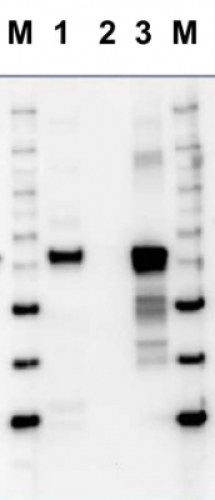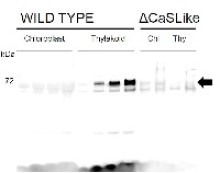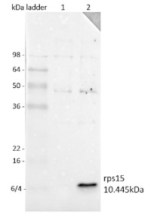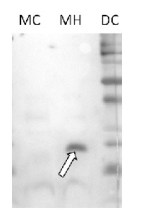
RbcL II | Rubisco form II positive control/quantitation standard
(Cat#: AS15 2955S)


Description
- Format: Lyophilized in glycerol.
- Reconstitution: For reconstitution add 90 μl of sterile water. Please notice that this product contains 10% glycerol and might appear as liquid but is provided lyophilized
- Storage: Store lyophilized/reconstituted at -20°C; once reconstituted make aliquots to avoid repeated freeze-thaw cycles. Please remember to spin the tubes briefly prior to opening them to avoid any losses that might occur from material adhering to the cap or sides of the tube.
- Tested applications: Western blot (WB)
- Recommended dilutions: Standard curve: 3 loads are recommended (0.5, 2 and 4 μl).For most applications a sample load of 0.2 μg of chlorophyll/well will give a RbcL signal in this range.Positive control: a 2 μl load per well is optimal for most chemiluminescent detection systems. Higher standard concentration needs to be used to allow detection by Coomasie stains. Such gels with higher standard concentration can not be used for quantitation using chemiluminescence.This standard is stabilized and ready and does not require heating before loading on the gel.Please note that this product contains 10% glycerol and might appear as liquid but is provided lyophilized. Allow the product several minutes to solubilize after adding water. Mix thoroughly but gently Take extra care to mix thoroughly before each use, as the proteins tend to settle with the more dense layer after freezing.
- Expected | apparent MW: 52.7 kDa
- Rubisco (Ribulose-1,5-bisphosphate carboxylase/oxygenase) catalyzes the rate-limiting step of CO2 fixation in photosynthetic organisms. Form II Rubisco is present in many photosynthetic bacteria and archaea and in some photosynthetic dinoflagellates.Source of Rubisco standard: Overexpressed RbcL form II protein
- Bausch et al. (2019). Combined effects of simulated acidification and hypoxia on the harmful dinoflagellate Amphidinium carterae. Mar Biol 166: 80. https://doi.org/10.1007/s00227-019-3528-y.
- Concentration: after re-constitution with sterile milliQ water final concentration of the standard is 0.15 pmoles/µlProtein standard buffer composition: Glycerol 10%, Tris Base 141 mM, Tris HCl 106 mM, LDS 2%, EDTA 0.51 mM, SERVA® Blue G250 0.22 mM, Phenol Red 0.175 mM, pH 8.5, 0.1 mg/ml PefaBloc protease inhibitor (Roche), 50 mM DTT.This standard is ready-to-load and does not require any additions or heating. It needs to be fully thawed and thoroughly mixed prior to using. Avoid vigorous vortexing, as buffers contain detergent. Following mixing, briefly pulse in a microcentrifuge to collect material from cap.This standard is stabilized and ready and does not require heating before loading on the gel. Please note that this product contains 10% glycerol and might appear as liquid but is provided lyophilized. Allow the product several minutes to solubilize after adding water. Mix thoroughly but gently Take extra care to mix thoroughly before each use, as the proteins tend to settle with the more dense layer after freezing.Please, use the 55 kDa size of RbcL for calculations. The pmoles in the standard refer to pmoles of rbcL monomers.
Boca Scientific is your premiere source for high-quality, innovative solutions for Cell Biology, Molecular Biology, Immunology, genetics and other lab products and reagents. We bring leading-edge products from our own-line and around the world to laboratories in the US and Canada. Our goal is to offer excellent solutions to drive research and discoveries backed by superior customer support.



